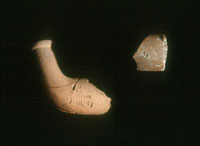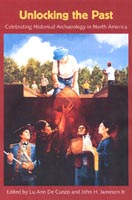The Archaeology of Rural Industry
David R. Starbuck

The author discusses the discovery of two smoking pipe fragments at a Shaker village of Pleasant Hill, Kentucky. These fragments were discovered at the Shaker washhouses, where the Sisters washed the clothing for each communal Shaker family. This suggests that smoking was also common among the women doing hard, tedious laundry work, which challenges the traditionally held gender stereotypes among the Shakers.
Perhaps the greatest problem for archaeologists like me is deciding which industrial sites are important, because I'm inclined to say "all of them!" So many mills, mines, and potters' shops left archaeological remains that it is hard to establish which ones feature examples of rare, older technology worth preserving, and which are no different from thousands of other industrial ruins. And is it only the rare, older examples that we should study and preserve? Some industrialists patterned their mills after a standardized guidebook, such as Oliver Evans' The Young Mill-wright and Miller's Guide, whereas other rural craftsmen showed a remarkable amount of ingenuity and creativity. That is why we need to view every industrial site as unique, a potential source of useful knowledge. In studying industrial processes, we want to rediscover what the millers learned through trial and error and to find out whether their old technology still has value and applicability in the world today.
Practical concerns determined the siting of many rural industries. Generally they had to be where fuel and raw materials could be obtained cheaply, where the labor supply was adequate, and where transportation could carry products to market. Unfortunately, we are now losing many of these sites of rural industry to development or “progress,” and so we must decide how to preserve and study these former ways of life before they are lost forever. We historical archaeologists have a tremendous opportunity to rediscover the lost beliefs, values and technologies of rural America by studying the many abandoned or soon-to-be-demolished industrial sites. Mills, furnaces, mines, craft shops, canals, fisheries, railroads, and many other industrial places have potential to provide technological knowledge that is no longer used in today’s workplaces. Too often industrial processes are forgotten in the rush to innovate and modernize. The remains and lessons we discover at industrial sites are helping to reconstruct a recent but poorly known past.
Featured Projects:
- Shaker Industry - David R. Starbuck
- The author recounts his his long-term project at a Shaker village, in Canterbury, New Hampshire, where three Shakers were still alive. After twenty-five years of recording their productions and industries, the author notes that the Canterbury Shakers were intrepid industrialists who operated a wide variety of machinery, and created a mill system that snaked for several miles.
- Lessons from Two Shaker Smoking Pipe Fragments - Kim A. McBride
- The author discusses the discovery of two smoking pipe fragments at a Shaker village of Pleasant Hill, Kentucky. These fragments were discovered at the Shaker washhouses, where the Sisters washed the clothing for each communal Shaker family. This suggests that smoking was also common among the women doing hard, tedious laundry work, which challenges the traditionally held gender stereotypes among the Shakers.
- Eli Whitney's Gun Factory - David R. Starbuck
- This section illustrates how industrial archaeology can help dispell myths about the origins of certain industries, such as gun manufacturing. In this case, the American System of Manufactures was rumored to have started at the Eli Whitney Gun Factory. With the help of a team of archaeologists, it was revealed that Whitney's manufacturing processes were no more innovative than those of other manufacturers of his day.
Other Featured Projects:
Musseling in the Mississippi Watershed - David R. Starbuck
Yulee Sugar Mills - Robin Denson
Bluff Furnace - David R. Starbuck
About the Contributors:
David R. Starbuck is Assistant Professor of Anthropology at Plymouth State University.
Kim A. McBride is Co-Director of the Kentucky Archaeological Survey at the University of Kentucky.
